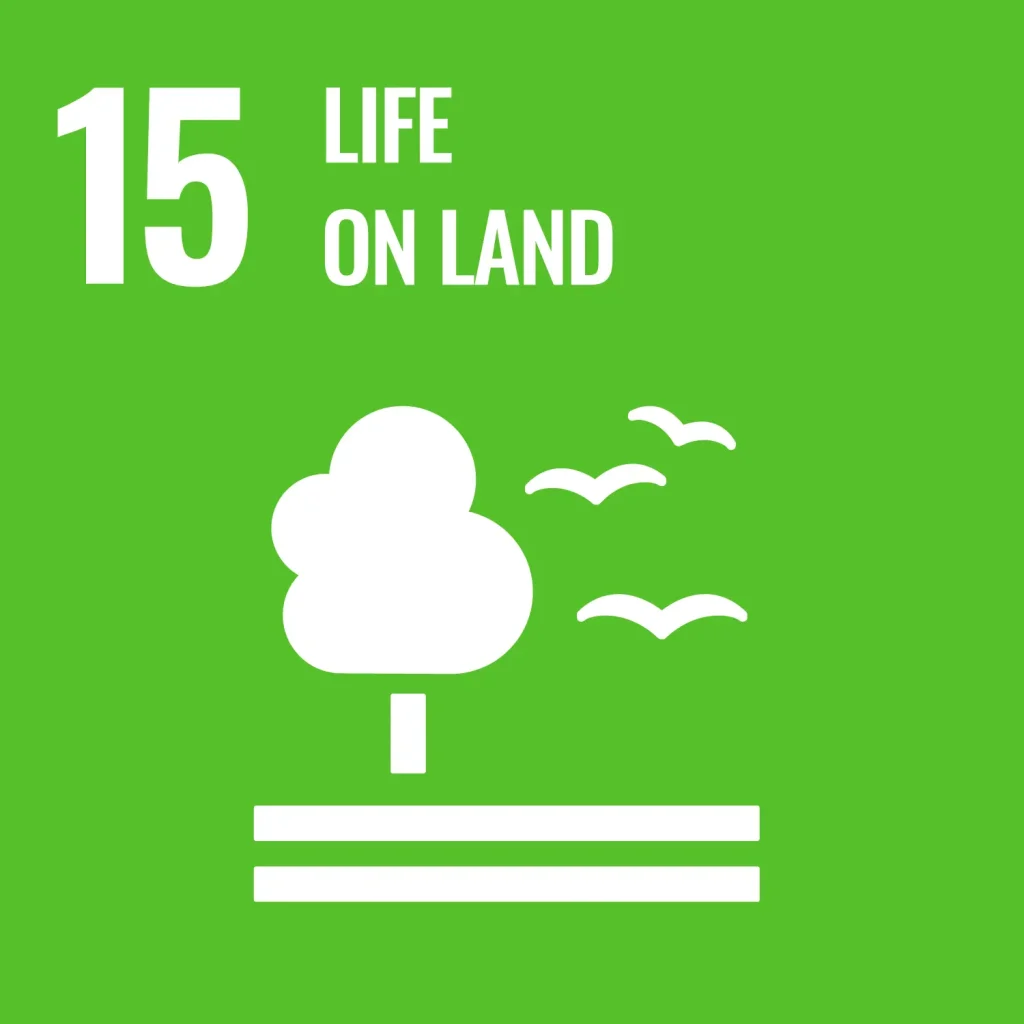
<span data-metadata=""><span data-buffer="">SDG 15:
LIFE ON LAND

Goal 15 of the UN’s 17 Sustainable Development Goals focuses on protecting, restoring, and promoting sustainable use of land and freshwater ecosystems. This goal recognizes their critical role in supporting life, providing resources like food and water, regulating climate, and maintaining a rich tapestry of biodiversity.
<span data-metadata=""><span data-buffer="">TARGET 15.1
Conserve and restore terrestrial and freshwater ecosystems
By 2020, ensure the conservation, restoration and sustainable use of terrestrial and inland freshwater ecosystems and their services
<span data-metadata=""><span data-metadata=""><span data-buffer="">INDICATOR 15.1.1
<span data-buffer="">Forest cover<span data-buffer="">
Indicator 15.1.1 is “forest area as a proportion of total land area” in the UN SDG framework.
Forest area is land under natural or planted stands of trees of at least 5 meters in situ, whether productive or not, and excludes tree stands in agricultural production systems (for example, in fruit plantations and agroforestry systems) and trees in urban parks and gardens.
<span data-metadata=""><span data-metadata=""><span data-buffer="">INDICATOR 15.1.2
<span data-buffer="">Protection of important biodiversity areas<span data-buffer="">
Indicator 15.1.2 is the “proportion of important sites for terrestrial and freshwater biodiversity that are covered by protected areas, by ecosystem type” in the UN SDG framework.
Protected areas are covered by three indicators: the proportion of total terrestrial area classified as protected; proportion of key terrestrial biodiversity areas that are protected; and proportion key freshwater biodiversity areas that are protected.
<span data-metadata=""><span data-buffer="">TARGET 15.2
End deforestation and restore degraded forests
By 2020 promote the implementation of sustainable management of all types of forests, halt deforestation, restore degraded forests and substantially increase afforestation and reforestation globally.
<span data-metadata=""><span data-metadata=""><span data-buffer="">INDICATOR 15.2.1
Progress towards sustainable forest management
Indicator 15.2.1 is “progress towards sustainable forest management” in the UN SDG framework.
Sustainable Forest Management (SFM) is composed of five sub-indicators that measure progress towards all dimensions of sustainable forest management.
Three sub-indicators focus on the expansion of forest area, above-ground biomass within the forest area and the protection of forest biodiversity. The fourth relates to the availability of a long-term forest management plan; and the final indicator measures areas which are independently verified for compliance with a set of national or international standards.
<span data-metadata=""><span data-buffer="">TARGET 15.3
End desertification and restore degraded land
By 2030, combat desertification, restore degraded land and soil, including land affected by desertification, drought and floods, and strive to achieve a land degradation-neutral world.
<span data-metadata=""><span data-metadata=""><span data-buffer="">INDICATOR 15.3.1
<span data-buffer="">End land degradation<span data-buffer="">
Indicator 15.3.1 is the “proportion of land that is degraded over total land area” in the UN SDG framework.
This indicator is assessed using three sub-indicators:
i) Trends in land cover: An example of land degradation due to land cover change is the conversion of forests into croplands or settlements.
ii) Trends in land productivity: Land productivity is measured in terms of Net Primary Productivity (NPP) of vegetation. Land is considered degraded in terms of productivity if its NPP is less than half the value of the 90th percentile NPP in the same region.
iii) Carbon stock: This is considered degraded if there is a net reduction of 10% or more in soil organic carbon between the baseline and current observations.
No data for this indicator
We haven’t been able to locate data for this specific indicator.
<span data-metadata=""><span data-buffer="">TARGET 15.4
Ensure conservation of mountain ecosystems
By 2030, “ensure that all men and women, in particular the poor and the vulnerable, have access to basic services.”2 This sets a target of universal access to basic services for all households.
<span data-metadata=""><span data-metadata=""><span data-buffer="">INDICATOR 15.4.1
<span data-buffer="">Coverage of important sites for mountain biodiversity<span data-metadata="">
Indicator 15.4.1 is “coverage by protected areas of important sites for mountain biodiversity” in the UN SDG framework.
This indicator measures the average share of each important site for mountain biodiversity that is covered by designated protected areas. The indicator does not measure the effectiveness of protected areas in reducing biodiversity loss, which depends on a range of management and enforcement factors.
<span data-metadata=""><span data-metadata=""><span data-buffer="">INDICATOR 15.4.2
Mountain Green Cover Index<span data-buffer="">
Indicator 15.4.2 is the “(a) Mountain Green Cover Index and (b) proportion of degraded mountain land” in the UN SDG framework.
The Mountain Green Cover Index measures the percentage of mountainous areas covered by some form of green vegetation.
The Index measures the changes of the green vegetation in mountain areas – i.e. forest, shrubs, trees, pasture land, crop land, etc. – in order to monitor progress on the mountain target. This is monitored through high resolution satellite imagery.
<span data-metadata=""><span data-buffer="">TARGET 15.5
Protect biodiversity and natural habitats
Take urgent and significant action to reduce the degradation of natural habitats, halt the loss of biodiversity and, by 2020, protect and prevent the extinction of threatened species.
<span data-metadata=""><span data-metadata=""><span data-buffer="">INDICATOR 15.5.1
Red List Index<span data-metadata="">
Indicator 15.5.1 is the “Red List Index” in the UN SDG framework.
The Red List Index (RLI) shows the trends in overall extinction risk for groups of species. An RLI value of 1.0 equates to all species in the group being categorised as ‘Least Concern’, and hence that none are expected to go extinct in the near future. A value of 0 indicates that all species have gone extinct.
<span data-metadata=""><span data-buffer="">TARGET 15.6
Protect access to genetic resources and fair sharing of the benefits
By 2030 promote fair and equitable sharing of the benefits arising from the utilization of genetic resources and promote appropriate access to such resources, as internationally agreed.
<span data-metadata=""><span data-metadata=""><span data-buffer="">INDICATOR 15.6.1
<span data-buffer="">Benefits of sharing genetic resources<span data-buffer="">
Indicator 15.6.1 is the “number of countries that have adopted legislative, administrative and policy frameworks to ensure fair and equitable sharing of benefits” in the UN SDG framework.
This indicator is measured through several sub-indicators that track countries’ participation in protocols concerned with the promotion and sharing of genetic resources for plants, food and agriculture, such as the Nagoya Protocol and the International Treaty on Plant Genetic Resources.
Israel is not a party to the Nagoya Protocol
Being party to the Nagoya Protocol means agreeing to follow the rules and guidelines set forth in the agreement,
which aim to ensure that the benefits of genetic resources are shared fairly and equitably, and that traditional
knowledge is protected and respected.
<span data-metadata=""><span data-buffer="">TARGET 15.7
Eliminate poaching and trafficking of protected species
Take urgent action to end poaching and trafficking of protected species of flora and fauna and address both demand and supply of illegal wildlife products.
<span data-metadata=""><span data-buffer="">TARGET 15.7.1
<span data-buffer="">Wildlife poaching and trafficking<span data-buffer="">
Indicator 15.7.1 is the “proportion of traded wildlife that was poached or illicitly trafficked” in the UN SDG framework.
Internationally comparable data on this indicator is not currently available, and is thus not reported here.
No data for this indicator
We haven’t been able to locate data for this specific indicator.
<span data-metadata=""><span data-buffer="">TARGET 15.8
Prevent invasive alien species on land and in water ecosystems
By 2020, introduce measures to prevent the introduction and significantly reduce the impact of invasive alien species on land and water ecosystems and control or eradicate the priority species.
<span data-buffer="">INDICATOR 15.8.1<span data-metadata="">
<span data-buffer="">Prevent invasive alien species<span data-buffer="">
Indicator 15.8.1 is the “proportion of countries adopting relevant national legislation and adequately resourcing the prevention or control of invasive alien species” in the UN SDG framework.
Alien species are those which have been introduced outside their natural distribution range through either intentional or accidental dispersion by human activity.
Invasive alien species impact native biodiversity thorugh competition for resources, predation, hybridisation, disease transmission, parasitism, herbivory and trampling and rooting. The outcomes of these impacts lead to biodiversity loss, habitat degradation, and loss of ecosystem services.
Limited Invasive Species Response
Israel lacks a centralized system dedicated to preventing biological invasions that threaten biodiversity and non-agricultural sectors. Several governmental agencies address aspects of invasive species control, but their powers and focus areas are limited. The Ministry of Agriculture primarily protects agricultural interests, while other agencies have varying levels of authority. Israel needs a stronger, multidisciplinary framework with clear authority and resources to effectively manage invasive species. This includes coordination between relevant agencies to ensure a comprehensive approach to protecting its environment.
<span data-metadata=""><span data-buffer="">TARGET 15.9
Integrate ecosystem and biodiversity in governmental planning
<span data-buffer="">INDICATOR 15.9.1<span data-metadata="">
<span data-buffer="">Integration of ecosystem and biodiversity in planning<span data-buffer="">
Indicator 15.9.1 is the “(a) number of countries that have established national targets in accordance with or similar to Aichi Biodiversity Target 2 of the Strategic Plan for Biodiversity 2011–2020 in their national biodiversity strategy and action plans and the progress reported towards these targets; and (b) integration of biodiversity into national accounting and reporting systems, defined as implementation of the System of Environmental-Economic Accounting” in the UN SDG framework.
Israel is using the System of Environmental-Economic Accounting
The System of Environmental-Economic Accounting (SEEA) combines economic and environmental data to give us a clearer picture of how the economy and environment interact. It also tracks changes in environmental resources and how they benefit society.
National target in place (Aichi 2), progress insufficient
Israel is not meeting 14 of the 19 national targets (about 74%) that it set for itself for the conservation of biodiversity and the timetables it committed to in the report to the Convention on Biological Diversity (CBD). Israel has also not ratified several conventions and protocols aimed at protecting the marine environment and the Mediterranean Sea and its shores, including the Barcelona Convention and several of its protocols, as well as the Convention on the Control of Transboundary Movements of Hazardous Wastes and Their Disposal.
<span data-buffer="">Data Source Attribution<span data-buffer="">
<span data-buffer="">SDG Target and Indicator Definitions:<span data-buffer="">
The definitions and descriptions of the Sustainable Development Goal (SDG) targets and indicators used on this website are credited to Our World in Data team (2023) – “SDG Tracker: Measuring progress towards the Sustainable Development Goals” Published online at OurWorldInData.org. Retrieved from: https://ourworldindata.org/sdgs
<span data-buffer="">Data for Graphs:<span data-buffer="">
Data used in the graphs and charts on this website were sourced from:
- Our World in Data
- National Insurance Institute of Israel
- Israel Central Bureau of Statistics
<span data-buffer="">Additional Notes:<span data-buffer="">
Built by students in the Sustainability and Information Technology course, University of Haifa.
Information updated as of March 2, 2024. We strive to provide accurate and up-to-date information. We encourage you to visit the websites of these organizations for further details and the latest data releases.

